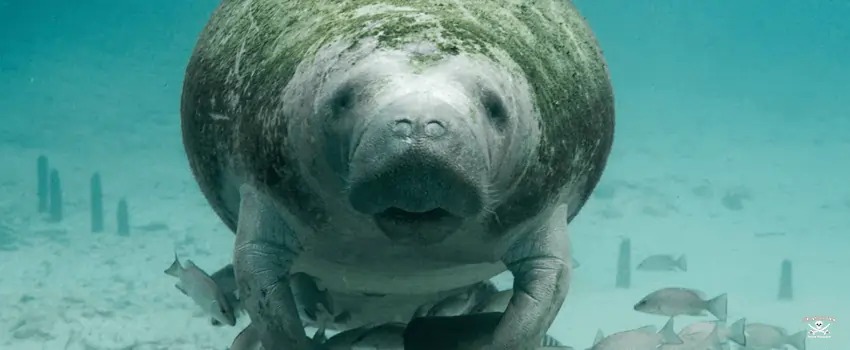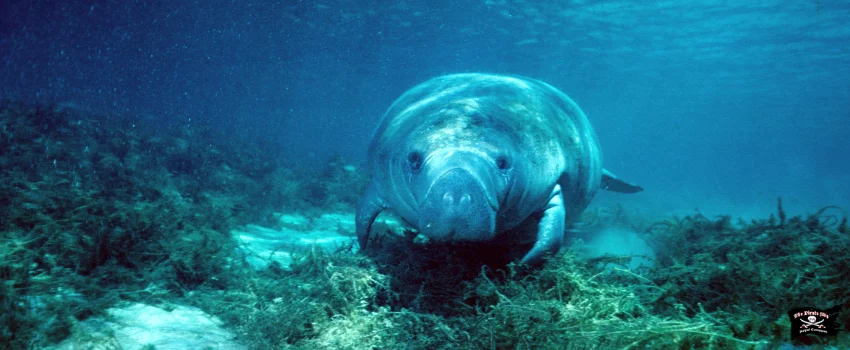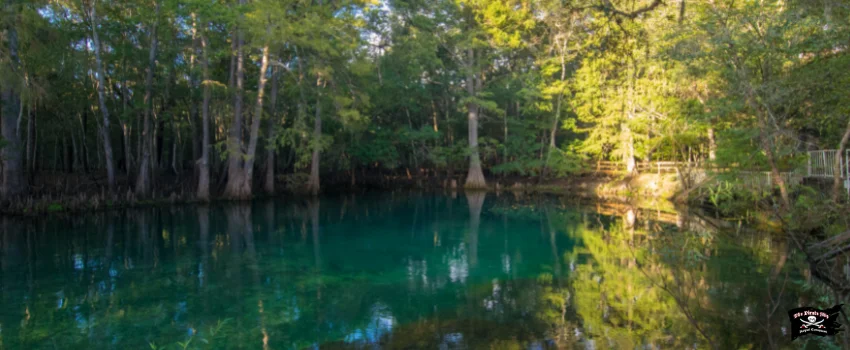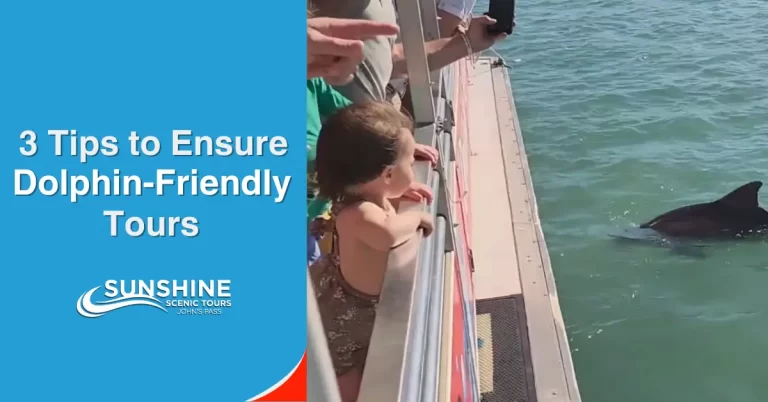For a manatee, even Florida waters can get a bit chilly. During the winter months when humans flock en masse to warmer weather, manatees disperse throughout Florida’s waterways. There are a lot of winter hangouts in Tampa bay, which hosts a sizable population of manatees. Come along as we answer the age-old question: where do manatees go in the winter?
Nature’s Ocean-dwelling Cow
Manatees may not be bovines, but the term sea cow has been around when describing these plump mammals for centuries. However, it’s a bit unfair to compare the two.
For instance, an adult manatee usually stretches 9-10 feet long from head to tail and may weigh over 1,000 pounds. By comparison, an adult female cow can weigh up to 1,600 pounds, while a bull can grow to be a staggering 2,400 pounds. That makes manatees rather petite!
Here’s one of many fun facts about manatees: did you know that, like land cows, sea cows come in various species? Currently, four species belong to the order Sirenia, or “sea cows,” as we usually call them. One of them is the dugong, and then the three types of manatees: The Amazonian manatees, the West African manatees, and the West Indian manatees. The ones in Tampa Bay are Floridian manatees, one of the two West Indian manatee subspecies. Of the three types of manatees, the Amazonian manatees are the smallest.
Sea cows used to have a fifth species known as Steller’s Sea Cow. First seen in 1741 by German zoologist Georg Wilhelm Steller, they could reportedly weigh up to 20,000 pounds, making them the largest of all the sea cows seen alive. Unfortunately, they went extinct 25 years later because European hunters returning and going to North America to obtain furs would eat them.
A better comparison would be between the manatee and a cow’s vegetarian diet. Similar to a cow’s diet of grass and hay, a manatee munches on seagrass. Sea oats are a particular favorite, which are protected in Florida’s coastal marine sanctuaries.
Manatee or Mermaid?
Spending weeks or even months at sea can do things to a person, both mentally and physically. Perhaps a steady diet of salt beef and stagnant water is to blame for the first sightings of mermaids. Half human, half fish, the mermaid has entered modern folklore as a mysterious creature of the deep. However, its origins are decidedly more humble. How attractive can a manatee be? Ask Christopher Columbus.
Explorer Christopher Columbus is credited with the first written sighting of a mermaid. Adding to his long list of mistakes, Columbus believed three manatees were the mysterious hybrid creatures. Describing them as “not as beautiful as they are painted,” the mermaid/manatee mix-up continued through the years.
While comparing beautiful, fish-tailed cryptic creatures to blubbery oblong manatees may seem ridiculous, it’s common enough that mermaid sightings continue to this day. The National Oceanic and Atmospheric Administration still receive calls from mermaid truthers on the regular seeking, well, the truth.
While mermaids don’t exist, it’s easy to see how manatees are mistaken for them. They can turn their heads as humans do, and they have flat tails and finger-like bones on their forelimbs.
Where To See Manatees in Florida
Florida’s manatee population lives throughout Tampa Bay during the summer months. Between April and October, the humble manatee cruises near docks and piers, searching for its favorite food: seagrass.
According to Save the Manatee, a Florida-based conservation group, 5,733 manatees lived in Florida waters as of 2019. While this number has decreased over the years, those that remain head inland toward Florida’s many springs during winter.
Visit inland springs and estuaries for the best place to see manatees in Florida. Even waters around power plants attract manatees, as they tend to be warmer than usual. One of the more popular spots to take pictures of manatees is the Crystal River National Wildlife Refuge.
Two hours north of John’s Pass at Madeira Beach, Crystal River’s history began as a refuge for manatees. Here, the manatees in Florida and others residing along Southern US coastal areas come together to ride out the winter months.
Other popular locations for manatees to gather for the winter include Fanning Springs State Park, Blue Spring State Park, and the aptly named Manatee Springs State Park. Kayaking and canoeing through these waters is a safe way to spot a manatee enjoying itself in the warm waters. Fortunately, you can rent kayaks and canoes at Clear Kayaking Tour Company when you visit these parks so you can wade out and see the manatees up close.
Nearer to St. Petersburg, manatee viewing is a popular pastime for locals and visitors. At the Teco Manatee Viewing Center, manatees drift through the warm waters to the delight of the viewing public. They even built a boardwalk for maximum manatee viewing.
Coffee Pot Bayou in St. Petersburg hosts wintering manatees and various shorebird and fish species. You can also visit ZooTampa to see manatees. They have a manatee critical care center where they rehabilitate and care for injured or ill manatees.
So, when you ask, “Where do manatees live?” or “Where do manatees go in the winter?” The answer is anywhere the waters are warm and the neighbors are friendly.
Protecting Our Friendly Neighborhood Manatee
In 1893, the Florida legislature made it illegal to capture or kill a manatee without a permit. Unfortunately, this protection only slowed the decline of the manatee population. The mammal became endangered upon the adoption of the Endangered Species Act of 1973. Conservationists and legislation worked to enact stronger protection for the manatees.
In 1978, the Florida Manatee Sanctuary Act came to be. This strong protection declares that “it is unlawful for any person, at any time, intentionally or negligently, to annoy, molest, harass, or disturb any manatee.” Coupled with the Federal Marine Mammal Protection Act of 1972, manatees now receive the strongest protection under the law. Since then, the species’ status has improved to Threatened rather than Endangered.
Still, dangers remain. Their interactions with humans remain their biggest threat. Keeping your distance and respecting the animal’s space goes a long way to the continuation of the species.
Enjoy watching manatees safely.
Hop on the Royal Conquest, the best Johns Pass Pirate Ship in Florida! You can easily spot manatees lolling about in the waters of Boca Ciega Bay with dolphins and other sea creatures while enjoying the pirate life.
Tours depart daily from St. Petersburg, Florida. Contact us today for your next adventure.











